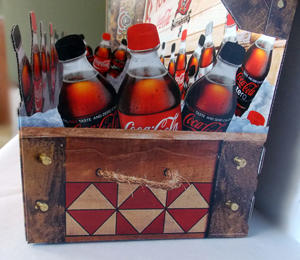Part 2 of 2 [Production Phase]

Designing and producing an effective retail merchandising display has its challenges for sure. The obvious ones include making sure the display is structurally sound; that it will withstand the rigors of store traffic and be able to hold the product its intended to display. This has a dramatic effect on how well the display does its job at increasing sales lift. In Part 1 of this 2 part article we emphasized how important the extra time spent in the Design Phase is… double and triple checking the engineering with whiteboards and prototypes.
In Part 2 we’ll take you through the print production and assembly process and share best practices in the workflow and the importance of quality control procedures along the way…
PHASE II: PRODUCTION
PRINT PRODUCTION: QUALITY WORKFLOW BEST PRACTICES:
Now that the specifications for the national beverage manufacturer’s treasure chest display have been finalized, the project is estimated and goes into production. Quality control at every step of the production process is critical for any POP campaign. Some of the workflow best practices may seem like no-brainers, but are no less important in assuring the project is on time, within budget, and it functions as intended. The ability to react to challenges along the way is also key.
KDM utilizes a Printer’s Management System that tracks a project’s status with modules that include estimating, order entry, inventory, scheduling, prepress, proofing, printing, finishing, packing and shipping. It also provides production data collection and job costing. Each department manager enters a completion code into the system as the product leaves their department. All support departments react to the schedule and any last minute changes.
Production Planners
As with any print job, efficiencies in production are critical. Production Planners work with the Estimating Team to produce the job the most efficient way considering the quantity, print method, materials, sheet size, press size, die size, and special considerations to color, finishing and packaging. They gang the different components of the job to get as many on the press sheet as possible to reduce costs and the press run time.
Project Managers
PM’s are the communication channel between the customer and production. They assemble the job ticket, artwork, prototypes and any other instructions that will then follow the job throughout the entire production process. Production & PM’s meet twice a day for updates that need to be related to the customer.
Pre-Press
The jobs are distributed to the proper pre-press operator depending on the print method (offset, digital, screen, flexo). An Epson color proof is output for approval of color and content, reviewed, and sent to the customer. Once the proofs are approved, the file is output to the specified medium; in this case film and screens were made. The Pre-Press Manager inspects and validates the output prior to its release into production.
Printing
The ink and material are prepared for the job, labeled, staged for press, and validated by the Screen Print Manager. The press operators will compare the raw materials to the specifications on the job ticket prior to setting up on press. In this case, a press check with the customer was not necessary. The manager will pull, inspect and sign off on the first prints and additional random parts throughout the run. The frequency of these checks may be either time or quantity. When the job is complete the quantities are validated. More complex displays require more print overs than usual to allow for the complex finishing.
Finishing
The inspection and validation process is consistent in each operation throughout the project’s finishing stage as well. Example: when the display gets die-cut and scored, the department manager checks the first piece against the specifications and the prototype and signs off. The manager will then inspect random samples and validate the final count. So, when the rope handles located on the sides of the display were assembled, the inspection and validation process started over again.
Kitting, Packing and Shipping
You guessed it- the kitting and packing process is also staged and signed off before it begins. As with many dimensional displays, a planogram is created and sent along in the kit to assure that it is properly displayed at the store level once it arrives.
The treasure chest display required careful packaging consideration because of the delicate die-cut bottles extending from it. KDM produced custom boxes for the kits in order to minimize shipping costs and get it there safely. Finally, the Shipping Manager signs off on the quantity, packing method and accuracy of the shipping labels. Project Managers then relay the shipping and tracking information to the customer to let them know their display has shipped.



On the more complex 3-D displays such as the treasure chest, inspecting and validating at every stage become even more critical. Have you ever seen a display fail in store? It’s not pretty. The extra time spent in the design phase is vital. Additionally, the quality control checks during the entire production stage make sure the display actually functions as designed, which improves the chance a retailer will place it prominently in their store and that your display performs as intended… INCREASING PRODUCT SALES!
